人教PEP小学英语六年级上册第二单元UnitTwoWaystogotoschool教案
- 格式:doc
- 大小:63.50 KB
- 文档页数:15

人教PEP版英语六年级上册Unit 2《Ways to go to school》单元教学设计一. 教材分析人教PEP版英语六年级上册Unit 2《Ways to go to school》主要围绕交通方式来学校这一主题展开。
通过本单元的学习,学生能够掌握表示交通方式的词汇和句型,如“by bus”, “on foot”, “by trn”等,并能够运用这些词汇和句型进行简单的交流。
教材通过富有趣味性的故事和情境,激发学生的学习兴趣,提高他们的语言运用能力。
二. 学情分析六年级的学生已经具备了一定的英语基础,能够听、说、读、写一些简单的英语单词和句型。
他们在学习过程中,需要通过丰富的教学活动和实践机会,进一步提高自己的语言运用能力。
同时,学生对于交通方式有一定的了解,可以通过生活经验和观察,更好地学习和掌握相关词汇和句型。
三. 教学目标1.知识目标:学生能够掌握表示交通方式的词汇和句型,如“by bus”,“on foot”, “by trn”等,并能够正确运用这些词汇和句型进行交流。
2.能力目标:学生能够通过听、说、读、写的训练,提高自己的语言运用能力,能够用英语简单介绍自己或他人的上学交通方式。
3.情感目标:学生能够激发对英语学习的兴趣,增强学习的自信心,培养合作和分享的良好学习习惯。
四. 教学重难点1.重点:学生能够掌握表示交通方式的词汇和句型,如“by bus”, “onfoot”, “by trn”等,并能够正确运用这些词汇和句型进行交流。
2.难点:学生能够灵活运用所学的词汇和句型,进行创编对话或故事,提高语言运用能力。
五. 教学方法1.情境教学法:通过创设生动、有趣的生活情境,激发学生的学习兴趣,提高他们的语言运用能力。
2.交际法:通过学生之间的互动交流,培养他们的合作意识和语言表达能力。
3.任务型教学法:通过完成具体任务,引导学生主动参与学习过程,提高他们的实践能力。
六. 教学准备1.教学课件:制作精美的教学课件,包括图片、动画、视频等,激发学生的学习兴趣。
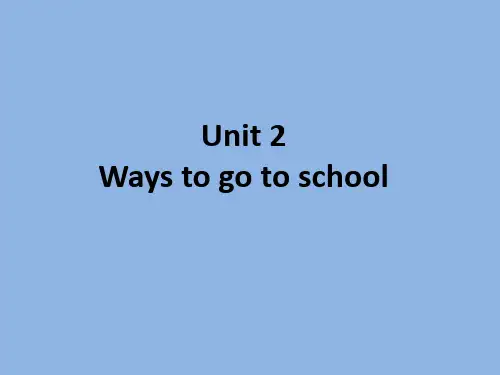
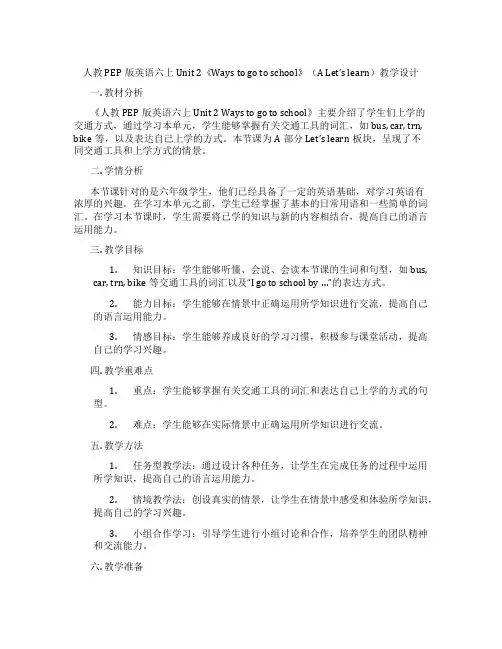
人教PEP版英语六上Unit 2《Ways to go to school》(A Let’s learn)教学设计一. 教材分析《人教PEP版英语六上Unit 2 Ways to go to school》主要介绍了学生们上学的交通方式,通过学习本单元,学生能够掌握有关交通工具的词汇,如bus, car, trn, bike等,以及表达自己上学的方式。
本节课为A部分Let’s learn板块,呈现了不同交通工具和上学方式的情景。
二. 学情分析本节课针对的是六年级学生,他们已经具备了一定的英语基础,对学习英语有浓厚的兴趣。
在学习本单元之前,学生已经掌握了基本的日常用语和一些简单的词汇。
在学习本节课时,学生需要将已学的知识与新的内容相结合,提高自己的语言运用能力。
三. 教学目标1.知识目标:学生能够听懂、会说、会读本节课的生词和句型,如bus,car, trn, bike等交通工具的词汇以及“I go to school by …”的表达方式。
2.能力目标:学生能够在情景中正确运用所学知识进行交流,提高自己的语言运用能力。
3.情感目标:学生能够养成良好的学习习惯,积极参与课堂活动,提高自己的学习兴趣。
四. 教学重难点1.重点:学生能够掌握有关交通工具的词汇和表达自己上学的方式的句型。
2.难点:学生能够在实际情景中正确运用所学知识进行交流。
五. 教学方法1.任务型教学法:通过设计各种任务,让学生在完成任务的过程中运用所学知识,提高自己的语言运用能力。
2.情境教学法:创设真实的情景,让学生在情景中感受和体验所学知识,提高自己的学习兴趣。
3.小组合作学习:引导学生进行小组讨论和合作,培养学生的团队精神和交流能力。
六. 教学准备1.教学课件:制作精美的课件,展示不同的交通工具和上学方式。
2.图片:准备各种交通工具的图片,用于教学展示和练习。
3.录音机:用于播放听力材料。
4.黑板:用于板书重点内容。
七. 教学过程1.导入(5分钟)利用图片展示各种交通工具,引导学生进行观察和思考,激发学生的学习兴趣。
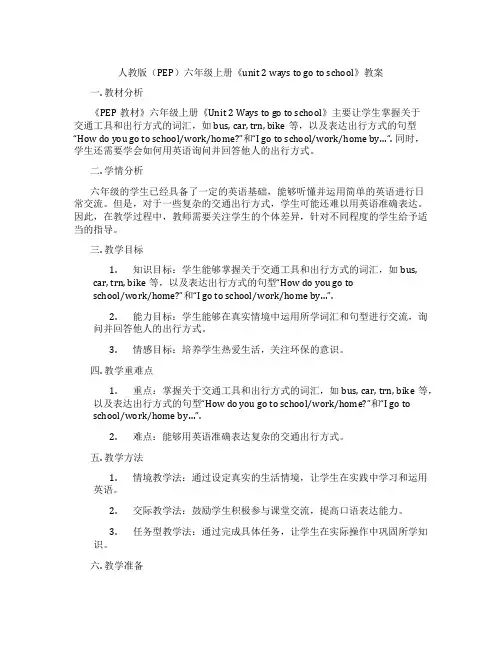
人教版(PEP)六年级上册《unit 2 ways to go to school》教案一. 教材分析《PEP教材》六年级上册《Unit 2 Ways to go to school》主要让学生掌握关于交通工具和出行方式的词汇,如bus, car, trn, bike等,以及表达出行方式的句型“How do you go to school/work/home?”和“I go to school/work/home by…”. 同时,学生还需要学会如何用英语询问并回答他人的出行方式。
二. 学情分析六年级的学生已经具备了一定的英语基础,能够听懂并运用简单的英语进行日常交流。
但是,对于一些复杂的交通出行方式,学生可能还难以用英语准确表达。
因此,在教学过程中,教师需要关注学生的个体差异,针对不同程度的学生给予适当的指导。
三. 教学目标1.知识目标:学生能够掌握关于交通工具和出行方式的词汇,如bus,car, trn, bike等,以及表达出行方式的句型“How do you go toschool/work/home?”和“I go to school/work/home by…”.2.能力目标:学生能够在真实情境中运用所学词汇和句型进行交流,询问并回答他人的出行方式。
3.情感目标:培养学生热爱生活,关注环保的意识。
四. 教学重难点1.重点:掌握关于交通工具和出行方式的词汇,如bus, car, trn, bike等,以及表达出行方式的句型“How do you go to school/work/home?”和“I go toschool/work/home by…”.2.难点:能够用英语准确表达复杂的交通出行方式。
五. 教学方法1.情境教学法:通过设定真实的生活情境,让学生在实践中学习和运用英语。
2.交际教学法:鼓励学生积极参与课堂交流,提高口语表达能力。
3.任务型教学法:通过完成具体任务,让学生在实际操作中巩固所学知识。
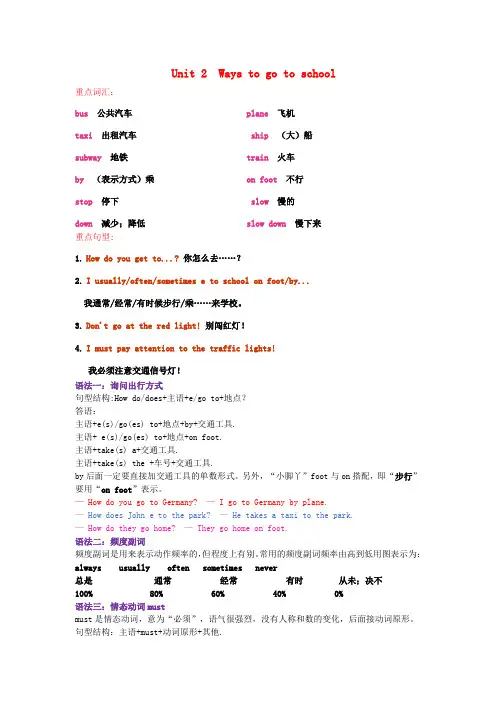
Unit 2 Ways to go to school重点词汇:bus 公共汽车 plane 飞机taxi 出租汽车 ship (大)船subway 地铁 train 火车by (表示方式)乘 on foot 不行stop 停下 slow 慢的down 减少;降低 slow down 慢下来重点句型:1.How do you get to...? 你怎么去……?2.I usually/often/sometimes e to school on foot/by...我通常/经常/有时候步行/乘……来学校。
3.Don't go at the red light! 别闯红灯!4.I must pay attention to the traffic lights!我必须注意交通信号灯!语法一:询问出行方式句型结构:How do/does+主语+e/go to+地点?答语:主语+e(s)/go(es) to+地点+by+交通工具.主语+ e(s)/go(es) to+地点+on foot.主语+take(s) a+交通工具.主语+take(s) the +车号+交通工具.by后面一定要直接加交通工具的单数形式。
另外,“小脚丫”foot与on搭配,即“步行”要用“on foot”表示。
— How do you go to Germany? — I go to Germany by plane.— How does John e to the park? — He takes a taxi to the park.— How do they go home? — They go home on foot.语法二:频度副词频度副词是用来表示动作频率的,但程度上有别。
常用的频度副词频率由高到低用图表示为:always usually often sometimes never总是通常经常有时从未;决不100% 80% 60% 40% 0%语法三:情态动词mustmust是情态动词,意为“必须”,语气很强烈,没有人称和数的变化,后面接动词原形。
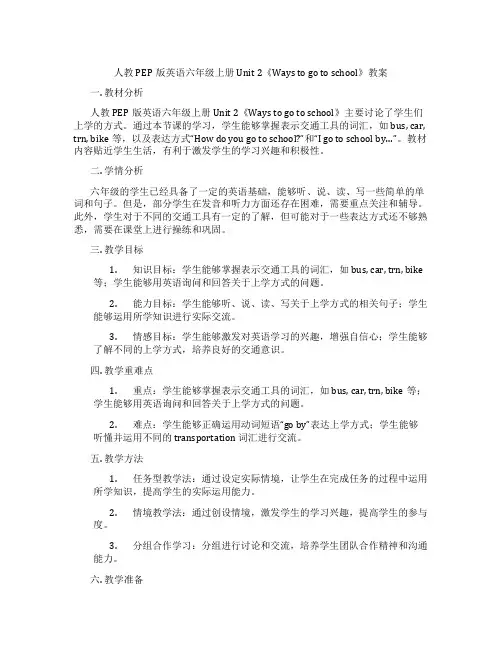
人教PEP版英语六年级上册Unit 2《Ways to go to school》教案一. 教材分析人教PEP版英语六年级上册Unit 2《Ways to go to school》主要讨论了学生们上学的方式。
通过本节课的学习,学生能够掌握表示交通工具的词汇,如bus, car, trn, bike等,以及表达方式“How do you go to school?”和“I go to school by…”。
教材内容贴近学生生活,有利于激发学生的学习兴趣和积极性。
二. 学情分析六年级的学生已经具备了一定的英语基础,能够听、说、读、写一些简单的单词和句子。
但是,部分学生在发音和听力方面还存在困难,需要重点关注和辅导。
此外,学生对于不同的交通工具有一定的了解,但可能对于一些表达方式还不够熟悉,需要在课堂上进行操练和巩固。
三. 教学目标1.知识目标:学生能够掌握表示交通工具的词汇,如bus, car, trn, bike等;学生能够用英语询问和回答关于上学方式的问题。
2.能力目标:学生能够听、说、读、写关于上学方式的相关句子;学生能够运用所学知识进行实际交流。
3.情感目标:学生能够激发对英语学习的兴趣,增强自信心;学生能够了解不同的上学方式,培养良好的交通意识。
四. 教学重难点1.重点:学生能够掌握表示交通工具的词汇,如bus, car, trn, bike等;学生能够用英语询问和回答关于上学方式的问题。
2.难点:学生能够正确运用动词短语“go by”表达上学方式;学生能够听懂并运用不同的 transportation 词汇进行交流。
五. 教学方法1.任务型教学法:通过设定实际情境,让学生在完成任务的过程中运用所学知识,提高学生的实际运用能力。
2.情境教学法:通过创设情境,激发学生的学习兴趣,提高学生的参与度。
3.分组合作学习:分组进行讨论和交流,培养学生团队合作精神和沟通能力。
六. 教学准备1.教材:人教PEP版英语六年级上册Unit 2《Ways to go to school》2.多媒体教学设备:用于展示图片、视频等教学资源3.教学卡片:用于单词和句子的操练4.计时器:用于控制教学环节的时间七. 教学过程1.导入(5分钟)利用多媒体展示不同交通工具的图片,如bus, car, trn, bike等,引导学生进行观察和思考。
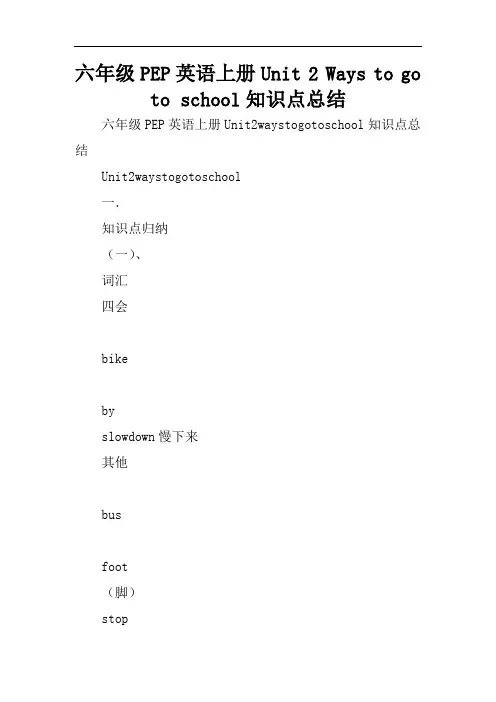
六年级PEP英语上册Unit 2 Ways to go to school知识点总结六年级PEP英语上册Unit2waystogotoschool知识点总结Unit2waystogotoschool一.知识点归纳(一)、词汇四会bikebyslowdown慢下来其他busfoot(脚)stop停下来交通工具traffictoolstrainhow(怎样)planegotoschool(上学)shiptaxi出租车ferry轮渡sled雪橇subway(交通工具前加by,表示乘坐,但步行要用onfoot)(二)、重点句型①询问交通方式用疑问代词how n——Howdoyougo/cometoschool?你怎样去/来上学?——Igo/cometoschoolonfoot. 我走路去/来上学。
n——Howdoes yourfathergotowork?你父亲怎样去上班?——Hegoestoworkbysubway.他坐地铁去上班。
②询问地点,用疑问代词where whereisyourhome?你家在哪里?It’s nearthepostoffice.在邮局旁边。
wherearetheteachers?老师们在哪儿Theyareintheteacher’soffice.在老师的办公室。
③问路:HowcanIgettotheFuxingHospital?我怎么去福星医院?youcantaketheNo.1bus.你可以乘坐1路公交车。
④交通规则:Stopandwaitataredlight.红灯停Goatagreenlight.绿灯行Slowdownandstop atayellowlight.黄灯停⑤youmustdriveslowly. youmustwearalifejacket. youmuststopataredlight你必须开慢点。
你必须穿救生衣。
你必须在红灯时停。
Don’tgoataredlight.Don’trunontheferry.Don’tletthedogsruntoofast. 不要在红灯时走。
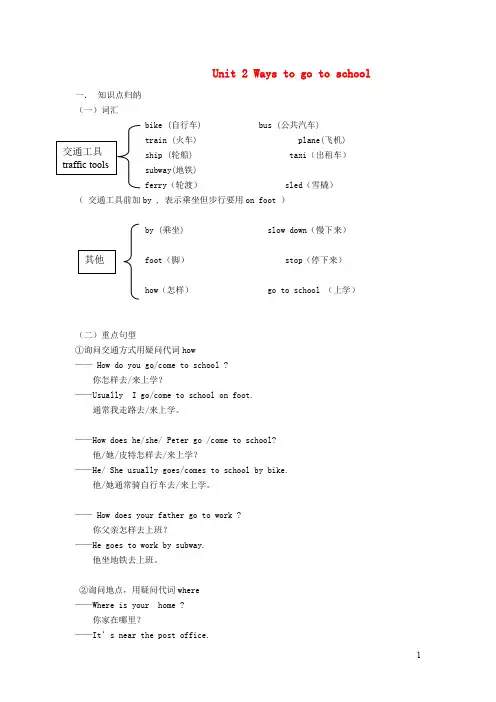
Unit 2 Ways to go to school 一.知识点归纳(一)词汇bike (自行车) bus (公共汽车) Array train (火车) plane(飞机)ship (轮船) taxi(出租车)subway(地铁)ferry(轮渡)sled(雪橇)(交通工具前加by , 表示乘坐但步行要用on foot )by (乘坐) slow down(慢下来)foot(脚)stop(停下来)how(怎样)go to school (上学)(二)重点句型①询问交通方式用疑问代词how—— How do you go/come to school ?你怎样去/来上学?——Usually I go/come to school on foot.通常我走路去/来上学。
——How does he/she/ Peter go /come to school?他/她/皮特怎样去/来上学?——He/ She usually goes/comes to school by bike.他/她通常骑自行车去/来上学。
—— How does your father go to work ?你父亲怎样去上班?——He goes to work by subway.他坐地铁去上班。
②询问地点,用疑问代词where——Where is your home ?你家在哪里?——It’s near the post office.在邮局旁边。
——Where are the teachers ?老师们在哪儿?——They are in the teacher’s office .在老师的办公室。
③问路——How can/do I get to the Fuxing Hospital?我怎么到福星医院? ——You can take the No .1 bus .④交通规则(traffic rules )Slow down and stop at a yellow light.黄灯面前要减速并停下来。
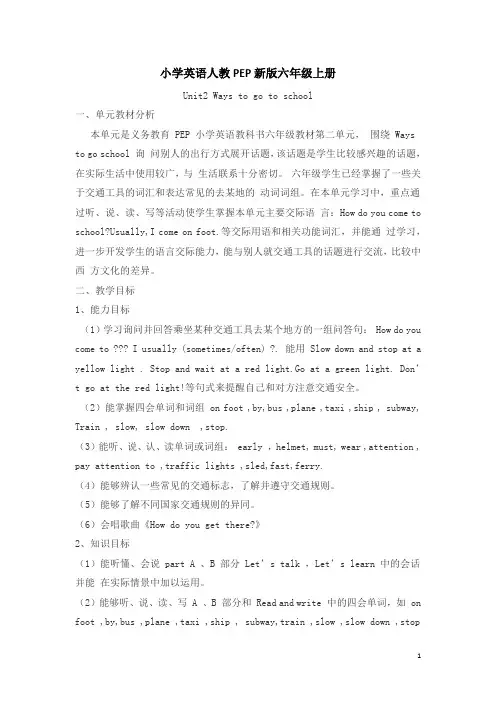
小学英语人教PEP新版六年级上册Unit2 Ways to go to school一、单元教材分析本单元是义务教育 PEP 小学英语教科书六年级教材第二单元,围绕 Ways to go school 询问别人的出行方式展开话题,该话题是学生比较感兴趣的话题,在实际生活中使用较广,与生活联系十分密切。
六年级学生已经掌握了一些关于交通工具的词汇和表达常见的去某地的动词词组。
在本单元学习中,重点通过听、说、读、写等活动使学生掌握本单元主要交际语言:How do you come to school?Usually,I come on foot.等交际用语和相关功能词汇,并能通过学习,进一步开发学生的语言交际能力,能与别人就交通工具的话题进行交流,比较中西方文化的差异。
二、教学目标1、能力目标(1)学习询问并回答乘坐某种交通工具去某个地方的一组问答句: How do you come to ??? I usually (sometimes/often) ?. 能用 Slow down and stop at a yellow light . Stop and wait at a red light.Go at a green light. Don’t go at the red light!等句式来提醒自己和对方注意交通安全。
(2)能掌握四会单词和词组 on foot ,by,bus ,plane ,taxi ,ship , subway, Train , slow, slow down ,stop.(3)能听、说、认、读单词或词组: early ,helmet, must, wear ,attention , pay attention to ,traffic lights ,sled,fast,ferry.(4)能够辨认一些常见的交通标志,了解并遵守交通规则。
(5)能够了解不同国家交通规则的异同。
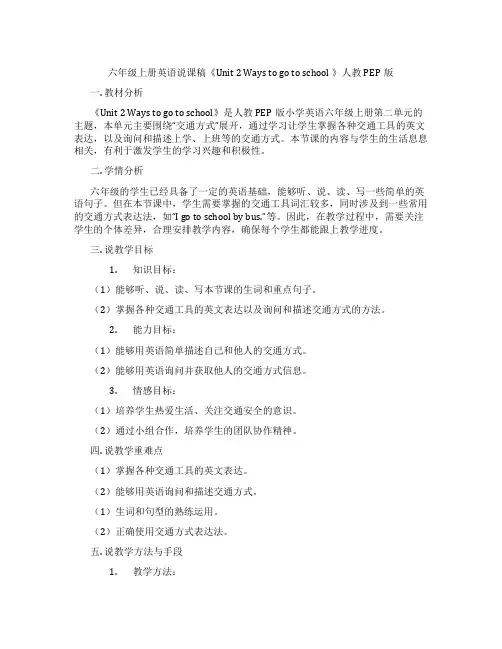
六年级上册英语说课稿《Unit 2 Ways to go to school 》人教PEP版一. 教材分析《Unit 2 Ways to go to school》是人教PEP版小学英语六年级上册第二单元的主题,本单元主要围绕“交通方式”展开,通过学习让学生掌握各种交通工具的英文表达,以及询问和描述上学、上班等的交通方式。
本节课的内容与学生的生活息息相关,有利于激发学生的学习兴趣和积极性。
二. 学情分析六年级的学生已经具备了一定的英语基础,能够听、说、读、写一些简单的英语句子。
但在本节课中,学生需要掌握的交通工具词汇较多,同时涉及到一些常用的交通方式表达法,如“I go to school by bus.”等。
因此,在教学过程中,需要关注学生的个体差异,合理安排教学内容,确保每个学生都能跟上教学进度。
三. 说教学目标1.知识目标:(1)能够听、说、读、写本节课的生词和重点句子。
(2)掌握各种交通工具的英文表达以及询问和描述交通方式的方法。
2.能力目标:(1)能够用英语简单描述自己和他人的交通方式。
(2)能够用英语询问并获取他人的交通方式信息。
3.情感目标:(1)培养学生热爱生活、关注交通安全的意识。
(2)通过小组合作,培养学生的团队协作精神。
四. 说教学重难点(1)掌握各种交通工具的英文表达。
(2)能够用英语询问和描述交通方式。
(1)生词和句型的熟练运用。
(2)正确使用交通方式表达法。
五. 说教学方法与手段1.教学方法:(1)情境教学法:通过设置生活情境,让学生在实际语境中学习英语。
(2)任务型教学法:通过完成各种任务,培养学生运用英语的能力。
(3)小组合作学习:激发学生的团队精神,提高课堂参与度。
2.教学手段:(1)多媒体课件:生动展示各种交通工具,提高学生的学习兴趣。
(2)实物道具:直观展示交通工具,帮助学生理解和记忆。
(3)课堂游戏:活跃课堂气氛,巩固所学知识。
六. 说教学过程1.热身(5分钟)(1)教师与学生用英语进行简单交流,提问学生上周学习的内容。
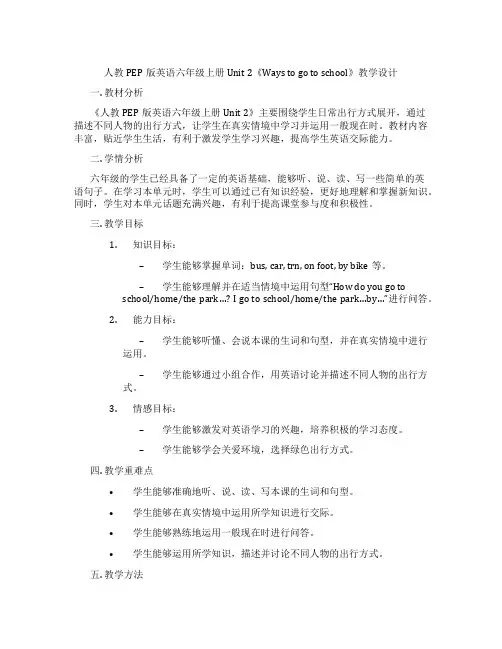
人教PEP版英语六年级上册Unit 2《Ways to go to school》教学设计一. 教材分析《人教PEP版英语六年级上册Unit 2》主要围绕学生日常出行方式展开,通过描述不同人物的出行方式,让学生在真实情境中学习并运用一般现在时。
教材内容丰富,贴近学生生活,有利于激发学生学习兴趣,提高学生英语交际能力。
二. 学情分析六年级的学生已经具备了一定的英语基础,能够听、说、读、写一些简单的英语句子。
在学习本单元时,学生可以通过已有知识经验,更好地理解和掌握新知识。
同时,学生对本单元话题充满兴趣,有利于提高课堂参与度和积极性。
三. 教学目标1.知识目标:–学生能够掌握单词:bus, car, trn, on foot, by bike等。
–学生能够理解并在适当情境中运用句型“How do you go to school/home/the park…? I go to school/home/the park…by…”进行问答。
2.能力目标:–学生能够听懂、会说本课的生词和句型,并在真实情境中进行运用。
–学生能够通过小组合作,用英语讨论并描述不同人物的出行方式。
3.情感目标:–学生能够激发对英语学习的兴趣,培养积极的学习态度。
–学生能够学会关爱环境,选择绿色出行方式。
四. 教学重难点•学生能够准确地听、说、读、写本课的生词和句型。
•学生能够在真实情境中运用所学知识进行交际。
•学生能够熟练地运用一般现在时进行问答。
•学生能够运用所学知识,描述并讨论不同人物的出行方式。
五. 教学方法1.情境教学法:通过设定真实情境,让学生在实践中学习并运用英语。
2.任务型教学法:通过小组合作,完成特定任务,提高学生的参与度和积极性。
3.游戏教学法:通过设计趣味游戏,激发学生的学习兴趣,巩固所学知识。
六. 教学准备1.教学课件:制作与本课主题相关的课件,辅助教学。
2.生词卡片:制作生词卡片,方便学生学习和巩固。
3.实物模型:准备不同交通工具的模型,方便学生直观地了解和学习。
人教版(共PEP)六年级上册英语《Unit 2 Ways to go to school?》说课稿说课稿一. 教材分析《Unit 2 Ways to go to school?》是人教版(共PEP)六年级上册英语教材的一个单元。
本单元主要围绕交通工具和出行方式展开,让学生学会询问和描述人们上学的方式。
通过本单元的学习,学生能够进一步巩固和运用已学过的单词和句型,提高听说读写的能力。
二. 学情分析六年级的学生已经具备了一定的英语基础,能够听懂并运用一些简单的英语句子进行交流。
但是,他们在语音、语法和词汇方面还存在一些困难,需要教师的耐心引导和辅导。
此外,学生的学习兴趣和动机对于英语学习来说至关重要,因此在教学过程中,我将会注重激发学生的学习兴趣,创设真实的学习情境,让他们在实践中学习和运用英语。
三. 说教学目标1.知识目标:学生能够掌握表示交通工具的词汇和询问出行方式的句型,如“How do you go to school?”和“I go to school by bus.”等。
2.能力目标:学生能够在真实情境中运用所学的词汇和句型进行交流,提高听说读写的能力。
3.情感目标:培养学生热爱生活,关注环保的意识,鼓励他们选择绿色出行方式。
四. 说教学重难点1.重点:学生能够准确地使用表示交通工具的词汇和询问出行方式的句型进行交流。
2.难点:学生能够熟练地运用所学的词汇和句型,在真实情境中进行对话。
五. 说教学方法与手段1.教学方法:采用情境教学法、任务型教学法和交际法,让学生在真实的情境中学习和运用英语。
2.教学手段:利用多媒体课件、图片、卡片等辅助教学,激发学生的学习兴趣,提高课堂效果。
六. 说教学过程1.导入:通过展示各种交通工具的图片,引导学生谈论交通工具,为新课的学习做好铺垫。
2.新课呈现:引入新词汇和句型,让学生通过观察、听讲和模仿,掌握所学内容。
3.操练环节:通过小组活动、角色扮演等形式,让学生在实际情境中运用所学词汇和句型进行交流。
人教版小学英语六年级上册第二单元Unit2《Waystogotoschool》教案人教版小学英语六年级上册第二单元Unit 2 《Ways to go to school 》教案第一课时A Let’s learn & Write and say一、教学目标与要求:1.能够听、说、读、写短语:on foot,by taxi,by bus,by train,by plane,by ship,by subway。
2. 能够正确使用上述单词和词组谈论交通方式。
如句型:How do we get there? …能完成本页将出发地、目的地和交通方式进行匹配的活动。
二、教学重点、难点分析:本课时的教学重点和难点是掌握四会短语和A Let's learn部分中运用某种交通具去某地的表达法。
三、教学准备:多媒体课件。
单词图片四、教学步骤和建议:1.Step1.Preparation(1)复习频度副词:always,usually,often,sometimes,never的读音与词义。
(2)Let's chant教师放多媒体Let's chant部分的录音,学生先静听一遍,再跟录音轻声吟唱一遍。
教师再放录音,带着学生一起边唱边做动作.Step 2.Presentation1单词呈现Let's learn(1)教师拿出一辆玩具公交车,自问自答:“How do I go to school?I go to school by bike.”并在黑板上写下:by bus。
教师再重复刚才的句子并问某一学生:What about you?How do you go to school?'’学生如果回答:“Me too!”教师就继续问下一名学生,直到有不同答案,教师帮助学生说出完整的句子:“I go。
to school by…”并将相应的短语写在黑板上。
教师示范朗读,学生跟读.同法教授on foot,by taxi,by train,by plane,by ship,by subway。
Unit 2 Ways to go to school一、表示出行方式:①by+交通工具(介词短语,位于句末)=take+a/the+交通工具(动词短语,位于句中)①表示步行去某地:go (to)+地点+o n foot = walk (to)+地点例:I often go to school on foot. =I often walk to school. 我经常步行去上学。
He goes to work by bus.=He takes a bus to work. 他乘公共汽车去上班。
二、询问某人的出行方式:How do/does + 主语+ e ( to ) + 地点?①主语+e/es ( to )+地点+出行方式.①主语+e/es +出行方式.①By+交通工具.例:— How do you e to Beijing?— I e to Beijing by train.1、how怎样,用来询问方式,位于句首,引导特殊疑问句。
2、do/does:助动词,无实际意义,帮助构成疑问句,后接动词原形。
随着主语的变化而变化,主语为三单主语时用does,主语为非三单主语时用do。
3、e to后接地点名词,如果接地点副词(there,here,home)要把to去掉。
【来是e,去是go,get是到达,地点副词(there,here,home)前不带to,地点名词前要加to】三、表示动作发生频度的副词叫作频度副词,常见的频度副词有:always总是>usually 通常>often 经常>sometimes 有时>never从不注意:频度副词用于一般现在时。
u sually,sometimes既可以放在主语之前,也可以放在主语之后。
对频度副词进行提问要用how often(多久一次)四、What about...的用法:“ What about...?”中about 是介词,其后接名词、代词或动词ing 形式。
新人教版(PEP)六年级上册英语《Unit2 Ways to go to school》说课稿一. 教材分析新人教版(PEP)六年级上册英语《Unit2 Ways to go to school》主要介绍了人们去学校的方式。
本节课的主要内容是让学生能够听、说、读、写关于去学校的方式的词汇,如:on foot, by bike, by bus等。
同时,本节课还要求学生能够运用这些词汇描述自己和别人的上学方式。
二. 学情分析六年级的学生已经具备了一定的英语基础,能够听、说、读、写一些简单的词汇和句子。
但是,对于本节课所涉及的词汇和句子,学生可能还需要加强练习。
此外,学生可能对一些交通方式不够了解,需要教师在课堂上进行解释和引导。
三. 说教学目标1.知识目标:学生能够听、说、读、写关于去学校的方式的词汇,如:on foot, by bike, by bus等。
2.能力目标:学生能够运用所学的词汇和句型描述自己和别人的上学方式。
3.情感目标:培养学生热爱学校,热爱生活的情感。
四. 说教学重难点1.重点:学生能够听、说、读、写关于去学校的方式的词汇。
2.难点:学生能够运用所学的词汇和句型描述自己和别人的上学方式。
五. 说教学方法与手段1.教学方法:采用情景教学法、交际法、任务型教学法等。
2.教学手段:利用多媒体课件、图片、卡片等辅助教学。
六. 说教学过程1.导入:教师通过提问学生“How do you go to school?”引导学生谈论自己上学的方式,激发学生的学习兴趣。
2.新课呈现:教师通过展示图片和多媒体课件,引入本节课的交通方式词汇,如:on foot, by bike, by bus等。
3.操练:教师学生进行小组活动,让学生练习使用所学的词汇和句型描述自己去学校的方式。
4.拓展:教师引导学生谈论其他交通方式,如:by car, by trn, by plane 等,丰富学生的词汇量。
5.巩固:教师通过游戏、唱歌、角色扮演等活动,让学生在轻松愉快的氛围中巩固所学知识。
人教版PEP 小学英语六年级上册Unit 2 Ways to go to school 考点+练习一、根据句意、首字母和汉语提示,补全单词。
1. Miss Wang’s home is near the school. So she can e to school on f every day.2. Look! There is a (飞机) in the sky.3. I want to take a t to Sanya for this summer holiday.4. Which is faster, the (地铁) or the bus?5. Please put d your hand.6. S down! I want to get off the car.7. S and wait at a red light.8. Mrs Li wants to visit Tian’anmen Square (乘) bus.9. If you take a (出租汽车), you can go to school on time.10. My uncle usually goes to work by(公共汽车).二、选择正确的答案。
()1. —do they usually e to the library?—On foot.A. WhereB. HowC. Who()2. Yellow light means “”.A. goB. stopC. wait ()3. —Where is your home?—It’s the right of the science museum.A. inB. onC. of ()4. —the students go to school by bus?—No, they .A. Do; don’tB. Are; aren’tC. Is; isn’t()5. In the UK, drivers drive on the side of the road.A. leftB. rightC. straight()6. —Can I go by bus?—A. Yes, you can.B. I go there on foot.C. Take a taxi over there.()7. —How do they go to the zoo?—A. Yes, they do.B. They go there on foot.C. They go at 2:00.()8. I go to school foot, but sometimes I go car.A. by; onB. on; byC. by; by()9. We learn useful things now.A. mustB. has toC. may()10. —Pay attention to the traffic lights!—A. How many?B. OK.C. Of course I can.三、情景交际。
人教PEP版英语六上《Unit 2 Ways to go to school》(第3课时)教案一. 教材分析《Unit 2 Ways to go to school》是人教PEP版英语六上第三课时,主要讲述了人们上学和上班的不同方式。
本课时通过介绍不同人物的上学和上班方式,让学生学会用英语描述人们的出行方式。
教材通过丰富的插图和情景对话,让学生在真实的情境中学习英语,提高学生的语言运用能力。
二. 学情分析学生在进入本课时已经掌握了基本的英语语法和词汇,具备一定的听说读写能力。
但是,对于描述人们的出行方式这一主题,学生可能缺乏实际的体验。
因此,在教学过程中,教师需要通过图片、视频等教学资源,帮助学生建立起对出行方式的直观认识,激发学生的学习兴趣。
三. 教学目标1.知识目标:学生能够掌握表示出行方式的词汇和句型,如“by bus”,“on foot”等,并能够用英语描述人们的出行方式。
2.能力目标:学生能够在真实情境中运用所学知识进行交流,提高学生的语言运用能力。
3.情感目标:学生能够意识到不同的出行方式对环境的影响,培养学生的环保意识。
四. 教学重难点1.重点:学生能够掌握表示出行方式的词汇和句型,用英语描述人们的出行方式。
2.难点:学生能够在真实情境中运用所学知识进行交流,正确使用介词“by”和“on”。
五. 教学方法1.情境教学法:通过创设真实的情境,让学生在实际交流中学习英语。
2.交际法:通过小组讨论、角色扮演等方式,让学生在交流中提高英语能力。
3.任务型教学法:通过完成具体任务,让学生在实践中学习和运用英语。
六. 教学准备1.教学课件:制作包含图片、视频等教学资源的课件,帮助学生直观地了解不同的出行方式。
2.学生活动材料:准备相关的人物图片,供学生进行角色扮演和小组讨论。
3.板书设计:设计简洁明了的板书,帮助学生理解和记忆。
七. 教学过程1.导入(5分钟)通过提问方式引导学生回顾已学过的表示交通工具的词汇,如“bus”,“trn”等,为新课的学习做好铺垫。
Unit Two Ways to go to school第一课时一、教学内容:A: Let’s try/Let’s talk/Let’s wrap it up二、教学目标:1、知识与技能:能够正确听说朗读“How do you come to school?”询问别人的出行方式,并能够用句子“I come by…”进行回答。
能够正确听说认读以下生词:often、sometimes、usually 等以及短语 on foot\ by bike\by subway\talk about 等。
2、过程与方法:能够听懂,会说,会表演Let’s talk 的内容,并在真实场景中交流和运用。
3、情感态度与价值观:1)培养良好的语音、语调和语感。
2)常见的交通法知识。
三、教学重点:能够听懂,会说常用表达,并在实际应用在交流与应用。
四、教学难点:运用核心句型来询问别人的出行方式。
五、主要教法:讲、练、游戏六、教学准备:1、教师准备Let's start部分和主情景图的教学挂图。
2、教师准备本课时的录音。
3、教师准备Let's learn部分的单词卡片。
七、教学过程:1 、Warming-up2、Presentation and practiceShow a part of a picture and let the students guess.引出单词 bike,学习词组 by bike。
造句 I come to school by bike.Listen and guess. 播放小汽车的声音,让学生去猜是什么交通工具。
同样引出单词 car,学习词组by car造句I come to school by bike.讲解“by+交通工具”的用法,特例:步行 on foot3、Presentation学习Main scene (1)呈现图片,仔细观察图片,回答问题,Where are they? What can you see? (2)学生仔细观察图片,展开合理想象并回答老师的问题。
Where are they?They are at a cross road. What can you see? Four people and a subway station. (3)听录音,模仿朗读,理解对话内容。
(1) 指明朗读对话,并翻译主要句子的中文意思,掌握单词、句子的读法。
(2) 教师领读对话,学生模仿,齐读练习,生生对话,小组表演。
(3) 告诉学生应该遵守交通规则,红灯停,绿灯行。
学习Let’s try & Let’s talk(1) T: Today I come to school by bus. I usually come to school on foot. What about you? Do you come by bike or by bus? Do you come on foot or by car?(2)Listen to the tape .(3)快速反应游戏:教师说出某个短语,让学生做相应的动作并说出句子(4)听录音,跟读Let’s talk 内容,注意纠正学生的发音。
(5)解释usually/often/sometimes 单词的区别。
(6)同桌表演对话,培养学生学习语言,运用语言交流的能力,同时培养合作意识。
根据原对话进行创编及完成探究学习中的题目。
4、ConsolidationPlay a chain game 教师做动作,自问自答:How do I come to school? I come to school by bike,继续重复刚才的句子并问某一位学生,继续传递下去。
5、Homework(1)Listen and recite the dialogue.(2)完成课堂检测中的相关习题(3)结合本课学习内容Make a new dialogue and act it out.八、板书设计:Unit 2 Ways to go to schoolon foot / by taxi/ by bus / by train / by plane/ by ship/by subwayHow do we get there?第二课时一、教学内容:A: Let’s try &Let’s talk二、教学目标:1、知识与技能:能够正确听说,朗读:How do we get there?询问出行方式,并能够用 By 进行回答。
能够正确听说,认读单词,如 plane,bus,ship,等以及短语 on foot, by bike。
2、过程与方法:能够听懂,会说,会表演Let’s learn 的内容,并在真实场景中运用所学语言进行真实交流和运用。
在对话交流中使学生养成用英语交流的习惯,培养良好的语音,语调和语感。
3、情感态度与价值观:培养良好的语音、语调和语感。
三、教学重点:1.本课时的教学重点是听、说、读、写句型:How do you come to school? I usually/sometimes/often come on foot.四、教学难点:本课时教学难点是学生书写四会句子并能简单陈述选择某种交通方式上学原因。
五、主要教法:讲、练、游戏六、教学准备:多媒体课件、单词图片七、教学过程:Step1 Warming-up1.Greeting2.Let’s chant “How do you get there?”3.free talk T:Good morning!How do you come to school?S1:I go to school by…T: What about you? Do you go by bus?S2: …Step2 Presentation1. Let’s learn(1)Show a calendar and some transportation means. T:How do you come to school on Monday? S1:I come to school by bike. T:How do you come to school on Tuesday? S2:I come to school by car. T:How do you come to school on Wednesday? S3:I come to school on foot. 以此类推。
(2)借助图片解释词组 by plane/by taxi/by ship(3)听录音,模仿朗读,理解对话内容,完成探究性学习第一题。
(4)指明朗读对话,并翻译主要句子中文意思,掌握单词,句子读法。
(5)教师领读对话,学生模仿,齐读练习,生生对话。
(6)根据对话内容进行创编,完成探究性学习第二题。
2.学习 write and say。
(1)谈一谈所学的交通工具的特点有哪些? (2)你最喜欢哪种出行方式,为什么? (3)讲解 get 和 from 的意思,分析 How do you get to the USA from China? (4)出示一些地点,仿照例句书写句子。
(5)根据实际情况,选择交通工具作答,完成探究学习第三题。
Step 3 Consolidation教师事先准备一些打乱顺序的单词卡片,让学生读词后快速拼成正确的句子,或者填充句子,最后写出完整的句子。
Step4 Homework1.Listen and recite the dialogue.听录音并背诵对话。
2.Finish the relevant workbook exercises.完成课堂检测中的相关习题。
3.Make a new dialogue according to this lesson and act it out.结合本课学习内容创建一个新对话并将其表演出来。
八、板书设计:Unit 2 Ways to go to schoolHow do you come to school?I usually/sometimes/often...第三课时一、教学内容:B Let’s learn & Role-play二、教学目标:1、知识与技能:能够正确听说,朗读Don’t go at the red light. I must pay attention to the traffic lights. 能够正确听说,认读单词,如 helmet, wear, Mrs等以及短语 pay attention to。
2、过程与方法:.能够听懂,会说,会表演Let’s talk 的内容,并在真实场景中运用所学语言进行真实交流和运用。
在对话交流中使学生知道要注意安全,遵守交通规则,了解常见的交通符号。
3、情感态度与价值观:培养良好的语音、语调和语感。
三、教学重点:能够听、说、读、写描述交通规则的单词和词组:traffic lights, wait, slow down, go。
四、教学难点:本课时的教学难点是书写短语traffic light, slow down和理解动词stop,wait的含义。
五、主要教法:讲、练、游戏六、教学准备:多媒体课件、单词图片七、教学过程:Step1 Warming-up1.Greeting2.兔子舞游戏3. Let’s chant “How do you get there?”4.free talk T:Good morning!How do you come to school?复习如何询问别人出行方式句型。
学生可根据实际情况进行回答。
Step2 Presentation1.Let’s try(1)引起学生注意交通安全的意识。
我们几乎每天都要上下学,在路上大家觉得要注意什么呢,鼓励学生大胆开口。
(2)播放录音,完成探究性学习第一题(3)把三种指示灯贴在黑板上,引出 traffic lights. (4)展示模拟红黄绿灯,告诉学生交通规则。
(5)Let’s Play 红灯停,绿灯行,黄灯等。
2.Let’s talk.(1)播放录音内容,让学生总结大意。
(2)再次播放录音,完成探究性学习第二题。
(3)逐句跟读,教师讲解生词 helmet, wear 等。
(4)教师领读对话,学生模仿,齐读练习,生生对话。
(5)教师讲解美国人骑自行车需要遵守的交通规则。
(6)出示交通标示,小组讨论,完成探究学习第三题。
(7)教师用英语解释交通标志的意思。
Step 3 Consolidation教师事先准备一顶小黄帽,请另一名学生随意指出不同的颜色,头戴小黄帽的学生听指令,绿灯时行走,红灯时停止前行。